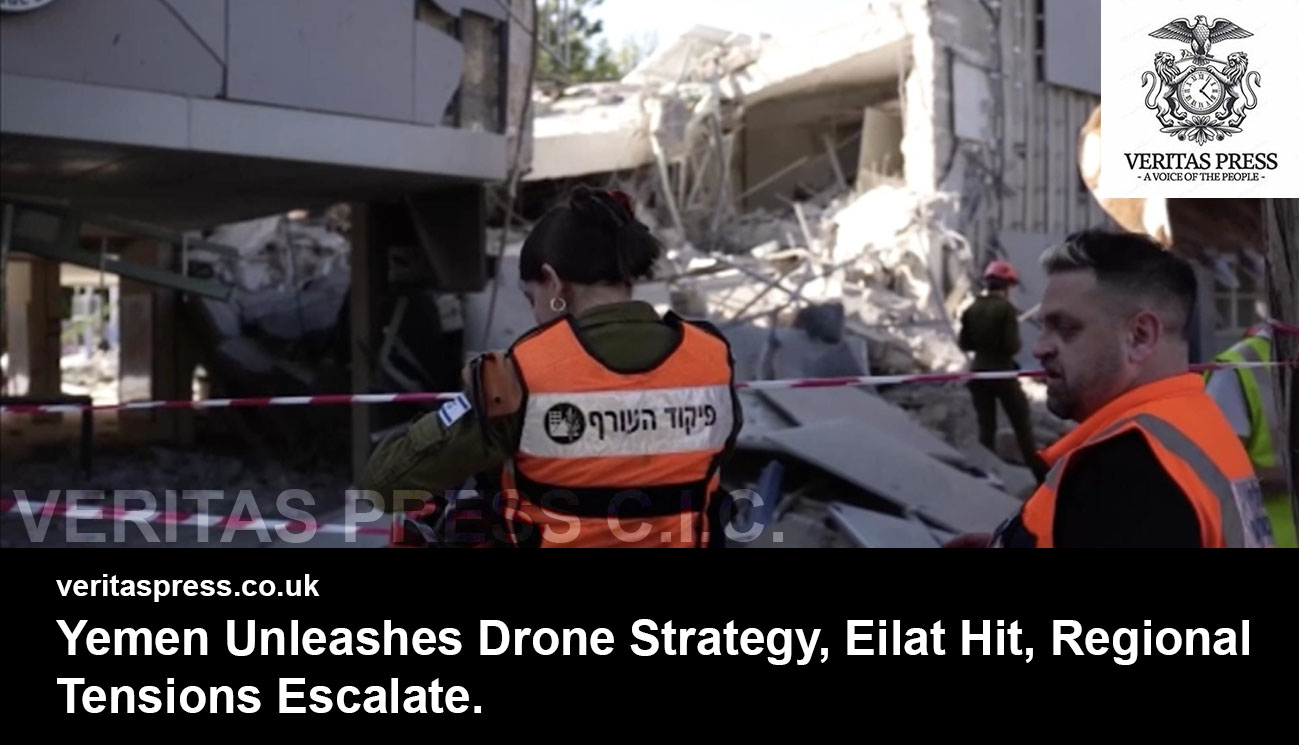YEMEN – On September 24, 2025, a drone launched from Yemen struck the Israeli city of Eilat, injuring 22 people, including two seriously. The drone crash occurred near the central port area and a hotel, causing both casualties and material damage. Eyewitnesses reported explosions and smoke rising over the city, while helicopters transported the wounded to hospitals in central Israel.
Israeli authorities confirmed that the Iron Dome defence system failed to intercept the drone. Two interceptor missiles were fired but missed their target, highlighting Israel’s vulnerabilities. The Israeli army said it attempted interception, but the low altitude and manoeuvrability made the drone difficult to track.
Yemen’s Evolving Drone And Missile Strategy:
According to Robert Inlakesh, Yemen’s ballistic missiles and loitering munitions are increasingly effective, often hitting their targets and exposing flaws in Israeli air defences. Following the Israeli assassination of Yemen’s Prime Minister Ahmed Ghaleb al-Rahwi and several cabinet members via airstrikes in Sanaa, Yemen’s Armed Forces escalated their operations, now often deploying multiple drones and ballistic missiles with cluster munitions simultaneously.
Recent Yemeni drone strikes impacted Ramon Airport, temporarily shutting it down, and targeted the Jacob Hotel in Eilat’s port area, causing fires and structural damage. Analysts note that these operations represent a strategic focus on crippling the Israeli domestic tourism sector, which heavily relies on cities like Eilat due to reduced international flights amid the Gaza conflict.
The Port of Eilat has long faced economic challenges, declaring bankruptcy, with the Red Sea blockade in 2024 estimated to have cost around $200 million. Tourism, the city’s economic lifeline, has also sharply declined, with many Israelis avoiding previously popular holiday destinations. Comparisons are drawn to Hezbollah’s campaign in northern settlements like Kiryat Shmona, which caused lasting tourism and demographic impacts.
Tactical Evolution And Psychological Impact:
The Yemeni “Yaffa” suicide drone, an enhanced Sammad variant with a 275 cc engine, can reach Tel Aviv from Yemen, evading radar through unconventional paths and low-altitude flight. Constructed from lightweight materials such as fibreglass and carbon fibre, it presents a detection challenge, even to advanced systems like the Iron Dome. The July 19, 2025, Tel Aviv strike killed one and injured ten, demonstrating Yemen’s capacity to reach Israel’s economic and governmental hub.
Analysts highlight the psychological impact on Israeli settlers, who now avoid regions like Eilat, the Golan Heights, and border areas, instead increasingly relocating to Cyprus, deepening a sense of isolation within Israel’s civilian population.
Israeli Retaliation And Limitations:
Israel’s response included airstrikes on Hodeidah port in Yemen on July 20, targeting fuel storage, port cranes, and power infrastructure. Six civilians were killed, and dozens were wounded, highlighting both Israel’s operational limitations and the risks of retaliating against a distant adversary.
Video shows Israeli F-35 and F-15 jets conducting strikes over 4,000 km, using Spice-guided missiles launched from outside Yemeni air defence ranges. Despite this, Yemen’s Ansarallah movement, led by Abdul Malik al-Houthi and Brig. Gen. Yahya Saree announced retaliatory measures, declaring Tel Aviv an “unsafe zone” and warning of a prolonged conflict targeting Israeli infrastructure, including gas platforms in the Mediterranean.
Western Influence And Broader Context:
The United States has actively supported Israel with military resources and targeted strikes on Houthi positions in Yemen, killing 31 individuals in March 2025, including journalists. Slovenia has also taken political action, imposing a travel ban on Netanyahu due to alleged war crimes in Gaza and enforcing an arms embargo on Israel.
Humanitarian Toll And Ongoing Genocide:
Israel’s ongoing military campaign in Gaza, beginning October 7, 2023, has killed over 100,000 Palestinians and wounded and maimed more than 377,000. Infrastructure destruction is unprecedented, and the blockade has caused widespread famine (AP News).
The combined effect of Yemeni drones, ballistic missiles, and regional resistance operations represents not only a direct military challenge to Israel but also a strategic and psychological blow, impacting civilian mobility, domestic tourism, and overall confidence in Israeli defence capabilities.
Conclusion: A Strategic And Geopolitical Turning Point.
The Yemeni drone and ballistic missile campaign represents more than a series of tactical strikes; it signals a seismic shift in the dynamics of asymmetric warfare in the Middle East. By successfully targeting Israeli cities, ports, and critical infrastructure, Yemen’s Ansarallah movement has exposed fundamental weaknesses in the Israeli defence apparatus, particularly the Iron Dome, which is increasingly overextended and incapable of fully defending against low-altitude, manoeuvrable drones.
Beyond the immediate military implications, the strikes have profound economic and psychological consequences. Eilat, a city reliant on domestic tourism and port commerce, faces mounting financial losses, potential long-term business closures, and an erosion of civilian confidence. The parallel with Hezbollah’s strategy in northern Israel illustrates how sustained, targeted campaigns can disrupt civilian life, force population displacement, and create enduring economic paralysis.
From a geopolitical perspective, the situation underscores the limits of Israeli military supremacy and the complex entanglement of Western influence, particularly the United States’ material and logistical support. While Washington and Tel Aviv have invested heavily in both offensive and defensive operations, these strikes reveal that technological superiority does not guarantee strategic success. Moreover, Israeli retaliatory attacks on Hodeidah port not only target civilian infrastructure in violation of international norms but also risk escalating regional tensions and drawing Saudi Arabia, Egypt, and other US-aligned states further into the conflict.
Crucially, the Yemeni campaign is inextricably linked to the ongoing genocide in Gaza, framing these strikes as part of a broader strategy of resistance within the Axis of Resistance. The tactical evolution of suicide drones, combined with precision targeting and calculated risk, allows Yemen to exploit vulnerabilities while advancing a political and moral narrative against Israeli aggression.
This unfolding conflict reveals the erosion of Israel’s perceived invulnerability, exposing domestic and international vulnerabilities that are as strategic as they are symbolic. Analysts, journalists, and regional observers caution that continued escalation, if unchecked, may not only paralyse Israeli infrastructure and economy but also reshape the regional balance of power. In short, Yemen’s drone and missile strategy is not just a military innovation; it is a sophisticated, politically and economically consequential campaign that challenges the very foundations of Israel’s occupation and its Western-backed military certainty.






























Leave a Reply